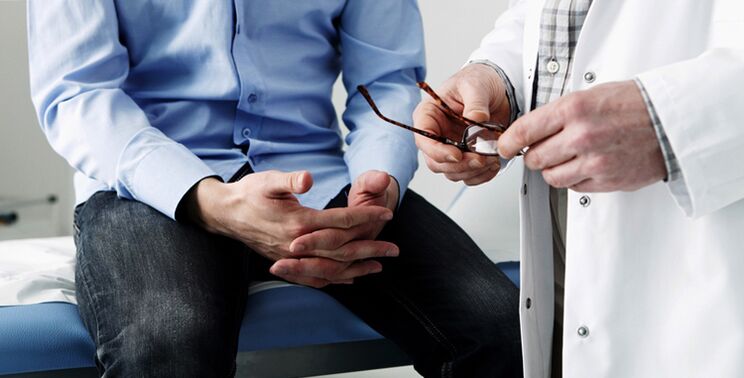The prostate gland is a gland in the male body. The normal parameters of a healthy organ are 2. 5-4. 5 cm long and 3-4 cm wide. It is composed of glandular and muscle tissue and is formed by the age of 23, when the accumulation of hormones increases. Glandular or secretory tissues produce a special fluid (secretory) that is secreted at the time of ejaculation and is a component of semen.
The bile of the prostate gland is alkaline and provides vitality and motility of the sperm, protecting them from the acidic environment of the vagina.
What is prostatic disease
This is an inflammation of the prostate gland, unique to the male body, related to the production of male sex hormones. Ligaments connect the gland to the pubic junction between the bones, its base converging with the bladder and surrounding the initial part of the urethra.
Located in a small pelvis, the prostate is separated from the rectum by a thin septum of connective tissue. This anatomical location of the prostate explains the complaints that arise when it becomes inflamed and enlarged. The gland presses on the urethra, thus causing poor urine output.
Compression of the rectum causes constipation. The location near the perineum causes this area to be painful.
Distribution of acute and chronic prostatitis.
Acute prostatitiscan be caused by different bacteria:
- Escherichia coli.
- Staphylococcus aureus.
- Enterococcus.
- Pseudomonas aeruginosa.
- Intestinal bacteria.
The presence of these pathogens in the body of a healthy person is natural and not harmful. But with a decrease in immunity, bacteria are activated, which penetrate into the tissues of the gland and cause acute inflammatory processes, which manifest:
- An increase in temperature, both in the whole body and in the rectum (in the rectum). Furthermore, the rectal temperature is usually higher than that of the armpit.
- Complaints of chills, fever.
- Pain in groin, scrotum, anus.
- Frequent painful urination (cramps, burning). The urge becomes more frequent at night.
- General poisoning. Weakness, muscle and joint pain, headache.
- Change in color of urine. It becomes cloudy, sometimes bloody.
- Excreted from the urethra.

Slow or progressive acute course lasting more than 3 months leading tochronic form.It is characterized by:
- Pain in the genital area.
- Violation of urination.
- Sexual disorder.
Main reason
- Urinary tract infections. For a long time, they can go unnoticed. The normal microflora of the genitourinary system copes with pathogenic flora for some time. But due to hypothermia or any other adverse condition, the active microflora begins to prevail and inflammation begins.
- Congestion in the prostateis a significant risk factor. A sedentary lifestyle, hemorrhoids, constipation - these factors lead to stagnant blood. The updated oxygenated arterial blood practically no longer flows into the pelvic organs. Intracellular respiration decreases and the infection becomes the sovereign mistress.
- Irregular sex life, - when periods of increased sexual activity are replaced by prolonged abstinence. The frequent as well as their limited ejaculation leads to stress and excretory dysfunction. Together with the above reasons, this sets the stage for the initiation of the inflammatory process.
- Fat. Disturbed metabolism leads to atherosclerosis and cholesterol deposition.
- HypothermiaMay reduce immunity.
- Alcohol and tobacco abuseleading to narrowing of the large vessels that feed the prostate.
- Lack of physical activitydoes not allow the muscles of the prostate gland to work and completely expel the secretions.
The first signs of prostatitis in men
- Weak urine stream with short range.
- Difficulty urinating with pain.
- The line is not continuous.
- Prolong urination.
- Incomplete bladder emptying.
- Frequent calls at night.
Symptoms and signs
There are two stages in symptoms: latent (hidden) and active. During the latent period, which can last for years, there are almost no complaints. Feeling a little tight in the scrotum, anus, or glans of the penis.
Men try to ignore it or see it as too much work. Over time, the pain increases, making it increasingly difficult to empty the bladder. This suggests that the latent stage has turned into the active phase, inflammation has begun to progress, and obvious signs of disease appear:
- Discomfort during defecation.
- Discharge from the urethra during stool.
- Burn in the perineum and urethra.
- Possible problems with potency.
- Rapid ejaculation.
- The bladder is partially emptied and difficult.
- Psychological problems.
- Frequent and painful urination with fibrous discharge.
- The process of the appearance of an erection becomes long.
Diagnose
- Prehistoric Collection. The doctor finds out all the complaints that the patient makes. Time of first symptoms. Presence of other diseases. Find out the details of sexual activity, the presence of a long-term partner, and other information needed for an accurate diagnosis.
- Rectal examination of the prostate. Before the examination, the patient was injected with microdialysis to clean the intestines. Palpation examination allows you to determine the increase and soreness of the organ. The results of prostate massage, a secret part is released, are assigned to the laboratory for study. The results allow you to determine the microflora of the gland and the sensitivity of pathogenic microorganisms to the drug.
- supersonic. This examination determines the size of the prostate gland, its density, and its structure. For a more detailed examination, transrectal ultrasound is used. The tip of the device is inserted into the rectum, which helps to examine part of the intestines and vas deferens.
- Cystoscopy. The procedure is done using an endoscope. A thin probe with a camera is inserted into the urethra, so you can see your bladder and glands on a monitor. As indicated, they may take a biopsy (take a tissue sample for analysis).

Laboratory studies are also carried out:
- General blood tests (increased white blood cell count).
- Urinalysis (white blood cells, red blood cells, and protein present in the samples).
- Bakposv on the microflora is taken from the urethra (sensitivity to antibiotics is determined).
- Sperm analysis (sperm motility, activity and accumulation, state of reproductive function).
Methods and plans for the treatment of prostatitis
The treatment is very complicated. Includes the preparation of different directions and actions, along with massage exercises, physiotherapy and therapy.
Prescription drugs:
- Broad spectrum antibiotic (affects pathogenic microflora).
- Alpha blockers normalize urine output, improve blood filling of the pelvic organs and relieve pain.
- Muscle relaxants.
Treatment also includes:
- Prostate massage (helps get rid of fluid retention and swelling). Acute infectious prostatitis is a contraindication to the procedure.
- Physical therapy (electrophoresis, electrical stimulation, magnetic and laser therapy).
- Physical therapy.
Only a doctor can prescribe medication after receiving these tests!
Prevent
- To prevent prostatitis, a mobile lifestyle is recommended. Walking, running, swimming, playing tennis are all very good for health. Strength sports and cycling should be limited.
- Diet. Eat foods rich in vitamins and minerals. Do not abuse alcohol and nicotine, limit eating sour foods, smoked meat.
- Be careful in choosing a sexual partner to avoid sexually transmitted diseases.
- Regular sex life.
Adhering to these simple precautions will allow you to stay healthy for many years.

























